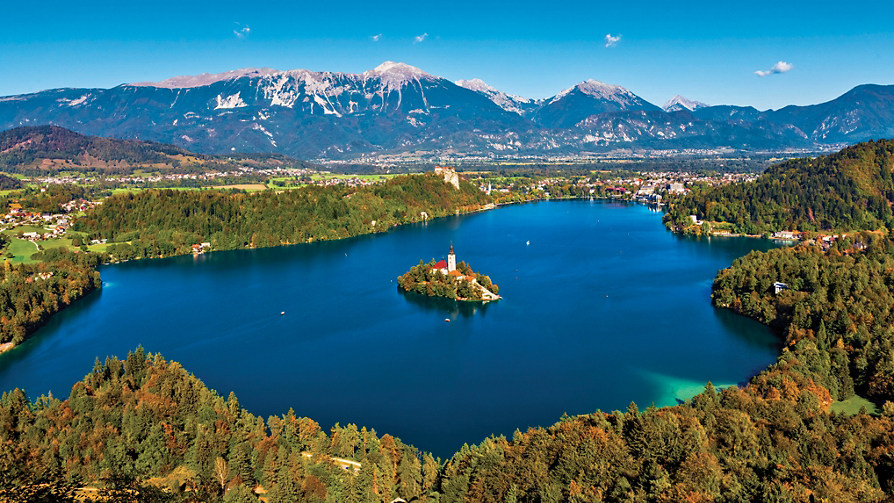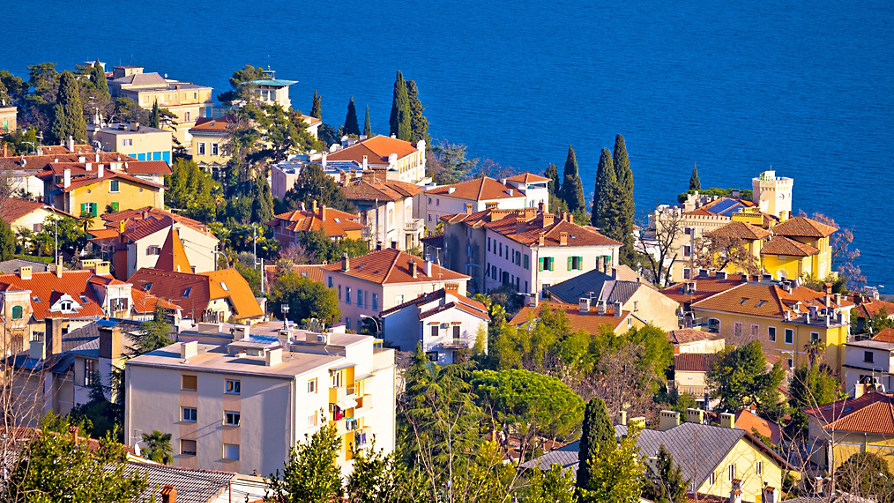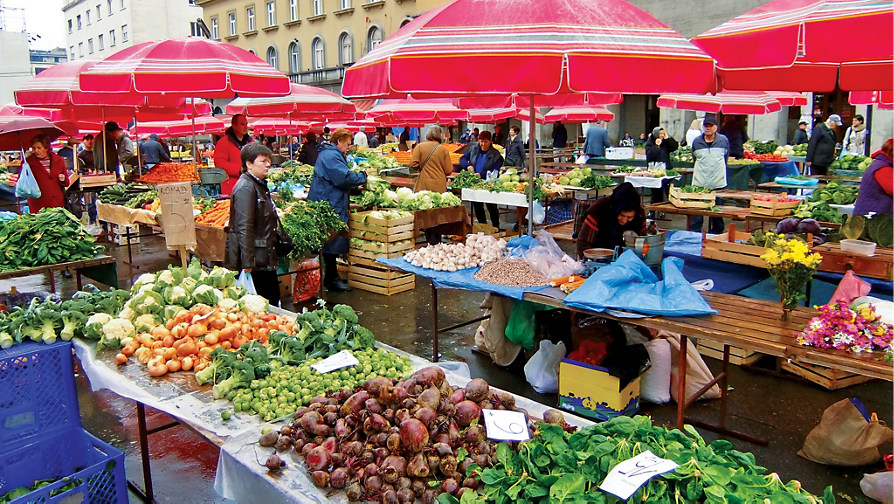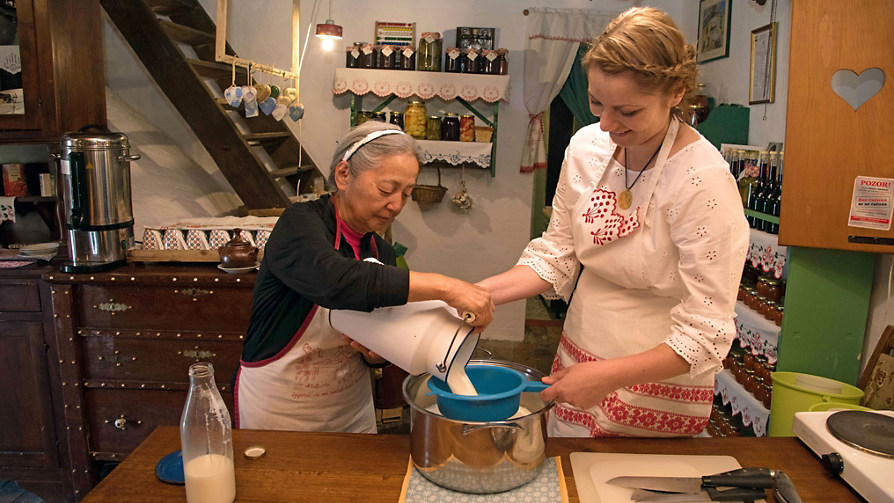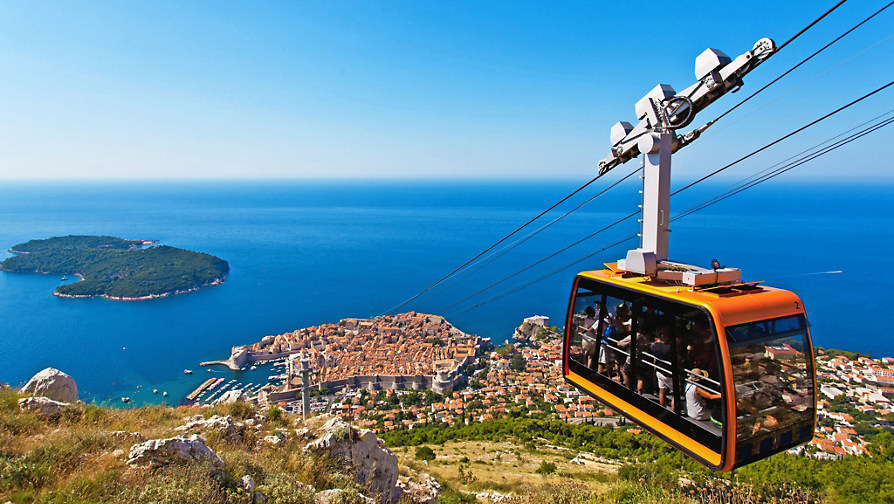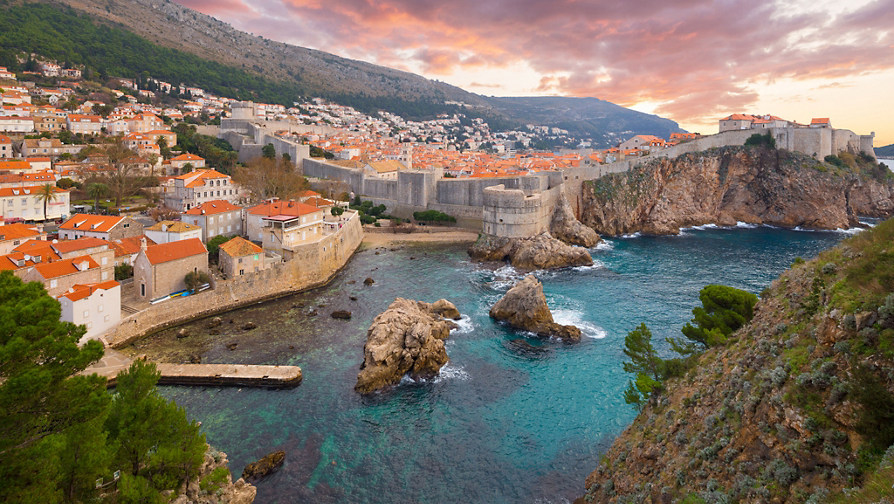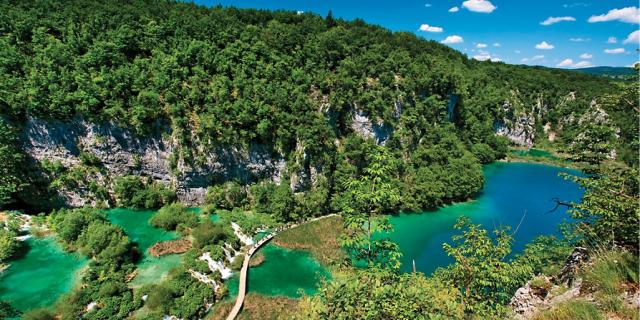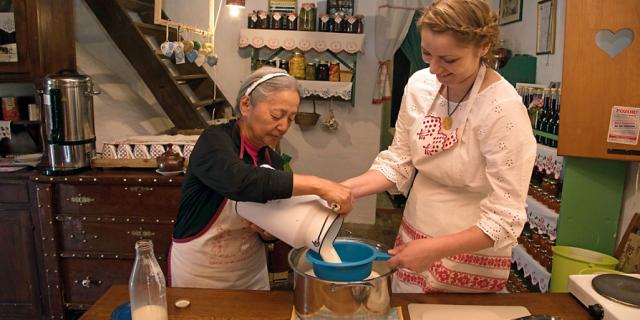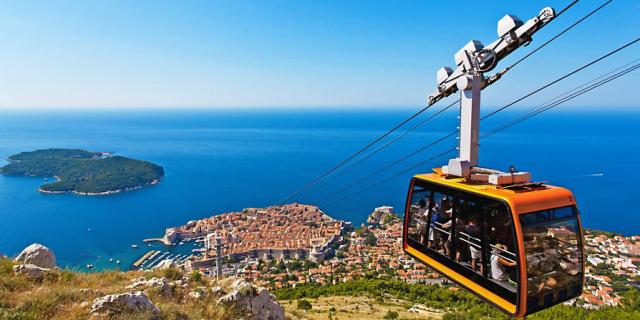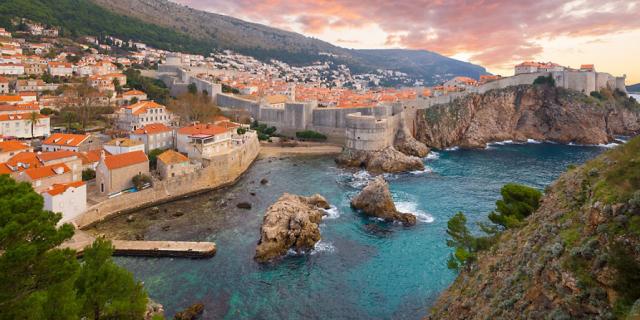- Explore in a small group of 8-16 travelers (average group size of 13)
- All land transportation
- Accommodations for 16 nights
- 32 meals—16 breakfasts, 8 lunches, and 8 dinners (including 2 Home-Hosted meals)
- 15 small group activities
- Services of a local O.A.T. Trip Experience Leader
- Gratuities for local guides, drivers, and luggage porters
- 5% Frequent Traveler Credit toward your next adventure
Please note:
Deposit requirement on land trips is $350
Past traveler savings of 5% if you traveled from 2018 onward
New travelers get $100 savings
On this adventure, which has an 87% traveler excellence rating, journey to the countries of Croatia, Montenegro, Bosnia & Herzegovina, and Slovenia—southeastern Europe’s multicultural lands of forgotten beauty. United as Yugoslavia after World War I, these diverse countries at the crossroads of Eastern and Western cultures coexisted peacefully—yet have been at the center of intermittent hostilities from the Middle Ages to the late 20th century.
Discover the heritage of the Balkans while witnessing stunning coastal scenery, exploring ancient walled cities, and experiencing the pride and resilience of the people of these re-emerging nations. Because we travel in a small group, we'll get to engage with locals in each country we visit and learn about their current lives, thoughts on Tito’s legacy, and wartime experiences—and discover how varied ethnic identities and traditions have often led to differing views about the events of the complicated breakup of Yugoslavia. Our small group size of 8-16 travelers also allows us to learn about these Controversial Topics during candid conversations with survivors of this tumultuous history, offering us firsthand perspectives on the sieges of Dubrovnik and Sarajevo during the Balkan wars. We'll also spend A Day in the Life of the village of Karanac in the Croatian countryside during an overnight stay at a family-owned farmstead—a feature exclusive to O.A.T. And enjoy two Home-Hosted Dinners with local families in Sarajevo and Karanac. Plus, to give you even more value on this adventure, we 've listened to traveler feedback and recently added an included visit to scenic Lake Bled, surrounded by lush forests, towering mountains, and medieval Bled Castle.
And whenever you’d like, you’ll have the freedom to explore more of the Balkans on your own: Break off from the group for independent discoveries—like soaking in an authentic Turkish hammam in Sarajevo—during free time. On this adventure, we’ll journey from the elegant walled city of Dubrovnik, Croatia and historic streets of Sarajevo, Bosnia, to the turquoise splendor of Croatia’s Plitvice Lakes and the towering peaks of Slovenia’s Julian Alps to discover a region that is rapidly re-establishing its rightful position among the world’s great travel destinations.
DAY 1
Depart U.S.
Fly overnight from the U.S. to Dubrovnik, Croatia.
DAY 2
Arrive Dubrovnik, Croatia
Destinations: Dubrovnik, Croatia
Meals included: D
Accommodations: Hotel Kompas Dubrovnik or similar
Afternoon: You’ll arrive in the city of Dubrovnik, Croatia this afternoon, based on your specific flight arrangements. Most flights arrive between 12pm and 5pm. Upon arrival, expect to spend about 1.5 hours clearing customs and completing any temperature checks or health guidelines your airline requires.
Travelers who have reserved their airfare with O.A.T. will also have their temperature checked by an O.A.T. representative before boarding the transfer vehicle, per our NEW health and safety protocols; those who do not reserve airfare with us will have their temperature checked upon arrival at the hotel. You will then be escorted to your hotel in the city by private car in groups of 1-2 or by private minivan in groups of 3-4, depending on the number of travelers who arrived with you. The transfer is approximately 40 minutes to 1 hour, depending on traffic.
At your hotel, you’ll meet your fellow travelers, including those who took our New! Landscapes & Culture of Turkey: From Cappadocia to Istanbul or Albania: Undiscovered Balkans pre-trip extensions. Though it depends on the exact hotel where we’ll be staying, many will feature an on-site bar, restaurant, wellness center, and spa. Typical rooms include a satellite TV, a mini bar, a safe, wireless Internet access, and a private bath with a hair dryer.
Later, around 4pm, our Trip Experience Leader will introduce us to the area with an approximately 30-minute orientation walk, pointing out locations you may need during your stay in Dubrovnik, such as ATMs, pharmacies, post offices, and restaurants.
Dinner: You will enjoy dinner around 6pm either at a local restaurant (where our orientation walk will end), or at our hotel, each featuring a selection of international and Croatian fare.
Evening: After dinner around 7:45pm, we’ll walk the short distance back to our hotel if we've dined at the restaurant (approximately 10 minutes), where you’ll enjoy the rest of the night at leisure. Perhaps you’ll enjoy a drink at the hotel bar with your fellow travelers, or stroll along one of Dubrovnik’s many seaside promenades.
DAY 3
Explore Dubrovnik
Destination: Dubrovnik
Meals included: B L
Accommodations: Hotel Kompas Dubrovnik or similar
Breakfast: Served at our hotel starting around 7am, featuring European options.
Morning: Around 9am, we'll gather for a Welcome Briefing with our Trip Experience Leader in the hotel. During this 45-minute briefing, we will introduce ourselves and review our itinerary in more detail (including any changes that may need to occur). Our Trip Experience Leader will also discuss logistics, safety and emergency procedures, and answer questions we may have—this is your chance to get them answered firsthand, whether you have questions about a particular optional tour, how much free time you’ll have during your first stay in Dubrovnik, specific activities or places you are hoping to see, and beyond.
Then around 10am we'll board a 30-passenger private motorcoach, operating at half capacity, to the gates of Dubrovnik's Old Town, Croatia's crowning jewel, arriving around 30 minutes later. Situated on a rocky spur at the country's southernmost tip, Dubrovnik is renowned for its medieval walls and historic monuments. Today, Dubrovnik's character reflects its storied past as an independent city-state that rivaled Venice. Also known by its Latin name, Ragusa, this was a fortress city that served as the base for a fleet of ships that carried trade between much of Europe and the Middle East. The city-state's period of autonomy extended from 1358 to 1808 and endowed it with a wealth of historic architecture.
In spite of heavy damage sustained during the breakup of Yugoslavia in the early 1990s, the city has regained its former splendor with the help of UNESCO. O.A.T. contributed to the restoration of Dubrovnik's main promenade, the Placa, through a donation from Grand Circle Foundation. Around 10:45am, we'll meet our local guide and embark on a 45-minute walking tour which includes visits to the fortified town center. We’ll also stop by the local market, where we’ll have the opportunity to get to know a few of the vendors and shoppers, and try a few local specialties like arancini (sweet candied orange peels).
Our tour ends at a 11:30am, and we’ll then have an hour before lunch to either explore independently, or join our Trip Experience Leader to discover more of Dubrovnik.
Lunch: Gather at a local restaurant, Lucin Kantun, around 12:30pm for a Welcome Lunch. We’ll meet the owner and his family, who will share with us the history of their restaurant, and serve a delectable meal of sporki makaruli, sauteed beef and macaroni, and rozata, a traditional Croatian custard crème dessert. While we dine, we'll hear from Ante, the chef and owner, who worked here for many years under the original management of former owner, Luce. When Luce decided to sell it, he put his faith in Ante and passed the restaurant down to him. In his honor, Ante kept the original name of the restaurant, Lucin Kantun, which means "Luce's Corner."
Afternoon: Following lunch around 1:30pm, your afternoon is free to explore Dubrovnik. You may wish to remain in Old Town and spend more time along the Placa (also called Stradun), visit the 15th-century Rector's Palace, or walk atop the city's ancient ramparts (a little over a mile in length), where you can enjoy views of the rooftops of Old Town and out into the blue Adriatic. Or, you can return to your hotel and use your all-day bus pass to explore another part of the city.
Dinner: On your own during your free afternoon in Dubrovnik. Perhaps you’ll sample one of the many restaurants in Old Town, which often specialize in seafood. You may return to the hotel by city bus whenever you like.
Evening: The rest of the evening is yours to rest, write in your travel journal, or reflect on your day in Dubrovnik.
DAY 4
Dubrovnik • Excursion to Kotor, Montenegro
Destination: Dubrovnik
Meals included: B
Accommodations: Hotel Kompas Dubrovnik or similar
Activity Note: Today, we’ll cross the border from Croatia to Montenegro in the morning, and cross back into Croatia in the afternoon. Please be aware that you will need your passport for all border crossings, and that sometimes crossing the border can take longer than expected—up to several hours depending on traffic.
Breakfast: Served at our hotel starting at 6am, with European options.
Morning: Around 7am, we’ll drive about 2.5 hours south—making one stop along the way—for a full-day excursion to Montenegro, a small country that is home to vast natural beauty—from soaring alpine mountains to a rugged coastline dotted with historic cities. Montenegro's history is unique in this region in that it managed to avoid being conquered by the Ottoman Turks in the 1300s, when they took control of the rest of the Balkans for the next four centuries.
Our first stop, around 9:30am, is Perast, an ancient village along the Bay of Kotor. We'll take advantage of our small group size to explore Kotor Bay aboard a private, small boat for an hour-long cruise. Our boat ride takes us south along the bay to the town of Kotor, a well-preserved medieval walled town situated at the head of southern Europe's deepest natural bay. Designated a UNESCO World Heritage Site, Kotor's Stari Grad, or Old Town, is filled with ancient churches and former aristocratic mansions that line narrow, cobbled streets. We’ll disembark around 11am and enjoy the sights of Kotor on a 45-minute city tour with a local guide.
After our tour, at around 11:45am, we’ll walk with our local guide to the Green Market, located just outside the city walls, arriving at around noon. Here, we’ll enjoy some people-to-people interaction as we walk amongst the stalls, chatting to merchants and locals, and stoke our appetites with a tasting of smoked ham and cheese.
Lunch: On your own in Kotor around 12:30pm. Your Trip Experience Leader can provide recommendations on the best restaurants for whatever your preferences are.
Afternoon: Enjoy some time on your own to explore Kotor. Then around 3:15pm, we’ll say goodbye to Montenegro for our return drive to Dubrovnik. We’ll arrive back at our hotel around 5:30pm.
Dinner: On your own in Dubrovnik. Perhaps you’ll sample the city’s famous black risotto (given its color from squid ink), or the region’s beloved mussels and oysters. Whatever your dinner preference, your Trip Experience Leader is sure to have recommendations.
Evening: Tonight, you’re free to continue exploring Dubrovnik on your own. You might walk along the nearby Adriatic, or enjoy a nightcap of rakija (the brandy of the Balkans) with your fellow travelers.
DAY 5
Explore Dubrovnik • Controversial Topic: Xenophobia in the wake of the Balkan War with Mira Knežević • Farmstead visit
Destination: Dubrovnik
Meals included: B D
Accommodations: Hotel Kompas Dubrovnik or similar
Exclusive O.A.T. Activity: Today we will learn about a Controversial Topic when we meet a Balkan War survivor for a firsthand account of how Dubrovnik was battered during its brutal siege, and about how old grudges from that war still linger today. Read more about this eye-opening experience below.
Breakfast: Served at our hotel starting around 7am, with European options.
Morning: Enjoy free time to explore the Old City of Dubrovnik this morning. Perhaps you'd like to journey through the history of 20th-century Croatia during a visit to the Red History Museum or soak up the medieval charms of St. Joseph Street located inside the defensive stone walls of the city. Or, you might rather spend some time exploring the baroque-style Dubrovnik Cathedral and its renowned array of interior artworks, such as a 16th-century triptych of the Ascension of Mary by the renaissance painter Titian.
Lunch: On your own. Check with your Trip Experience Leader for ideas. Perhaps you’ll grab a drink at Café Buza, tucked into the Old Town walls, or simply stroll the historic streets.
Afternoon: After lunch, we’ll depart our hotel around 1pm for a 30-minute drive to Old Town, where we will board the cable car that will take us up Srd Mountain, which lies just behind Dubrovnik. At 1,352 feet high, this peak offers idyllic views of the surrounding area, which we'll take in from different vantage points throughout our drive. We'll have an opportunity to witness sweeping vistas of Dubrovnik's towers and walls, as well as the steel-blue hue of the Adriatic.
Around 1:45pm, we'll disembark the cable car and walk about 15 minutes to the nearby War Museum, where we'll speak with an eyewitness about the Controversial Topic of the Homeland War of the Balkans and the impact it has had—and continues to have—on Dubrovnik, as well as the region. Today, Croatia still contends with having to rebuild war-torn edifices, but beyond crumbling infrastructure, the prejudice and xenophobia at the root of the conflict remains palpable. The location we'll be visiting is a painfully relevant setting for this conversation; considered a strategic war location, the Fortress in Srd Mountain suffered violent attacks from the Serbs, resulting in countless casualties around the area.
This afternoon, we'll learn how this turbulent period has shaped Croatia when we meet with Mira Knežević, a survivor of the war. Born and raised in Korčula, Mira moved to Dubrovnik to attend university, where she studied at the undergraduate and graduate levels. Over the years, she has worked as an educator and currently works as a translator and local guide, developing a deep knowledge of political history in the region. She is particularly informed about the Homeland War of the Balkans, having lived through it, which she'll provide ample background information on before outlining the residual effects that still permeate modern-day Croatian culture.
Following the Allied victory in World War II, Yugoslavia was formed as a federation of six communist republics with borders that divided populations according to ethnicity and background: Bosnia and Herzegovina, Croatia, Macedonia, Montenegro, Serbia, and Slovenia. From the very beginning of this union, Croatia experienced many challenging times—all which led up to the Homeland War of the Balkans (1991-1995). This high-stakes conflict was fought between Croat forces loyal to the government of Croatia, which sought independence from the republic of Yugoslavia, and the Serb-controlled Yugoslav People's Army, which vehemently opposed this secession.
On June 25th, 1991, Croatia officially escalated tensions by defying Serbian rule and declaring independence, after which years of siege, ground combat (often fought by local people who were not affiliated with any kind of military group), and various offensives followed. In 1995, two of these offensives—known as Operation Flash and Operation Storm—effectively ended the war in a victory for Croatia. In the wake of this enormous achievement, the country was sent into a tailspin, with an estimated $37 billion in damaged infrastructure and tens of thousands of people either displaced or killed (most of whom were Muslim Bosniaks and Catholic Croats). Furthermore, by the end of the war, around half of the population had sought asylum in the neighboring country of Bosnia and Herzegovina, leaving Croatia with a broken and dwindling populace. Decades later, the International Criminal Tribunal for the former Yugoslavia still works to assist victims, resolve war crimes, and establish punishments for war criminals involved in this prolonged conflict.
This may be a hard conversation, and we will confront the ugly realities of war and nationalism—about what has happened throughout history, and about the work that still needs to be done. Approach this experience and personal testimony with an open mind. We’ll hear Mira's stories for about 20 minutes, and then have around 45 minutes to ask any additional questions we may have, followed by a few minutes to explore the museum. Then around 3:15pm, we'll depart by private vans for the 30-minute ride back down to the Old City, stopping along the way to admire particularly beautiful viewing points.
Around 4pm, we'll then board a private motorcoach for a 1-hour drive to the rural Konavle region outside of Dubrovnik. Here, we’ll escape the tourists of Old Town to get a more authentic look at the area with a visit to a private, family-owned farmstead and winery—a recently added feature. Upon our arrival around 5pm, we'll be welcomed by Mr. Dario Martinovic, the owner of the farm, who will introduce us to his estate. After our introduction, he'll lead us to the wine cellar where we’ll enjoy a wine tasting of grappa, prosecco, one local red, and one local white—accompanied by local cheese, olives, and prosciutto—while we learn how all of these delicacies are produced. Then, at about 5:30pm, Dario will take us on a walk around his property, stopping at several points to explain the significance of a particular location, as well as how it has evolved throughout the history of the farm.
Dinner: At the family farmstead around 5:45pm, where we'll enjoy farm-fresh food and local music. Tonight's meal will consist of veal and lamb served "under the bell," a traditional preparation in which the meat is slow-cooked under a large, iron bell and covered with ashes and embers. The main dish will be served with potatoes and vegetables and followed by homemade apple pie for dessert. As you dine, enjoy the live folk music, and if you'd like, learn how to dance the Linđo, a traditional celebratory dance of Dubrovnik.
Evening: Around 7:30pm, we'll depart for the 30-minute private motorcoach ride back to the hotel. On your last night in Dubrovnik, you’ll be free to enjoy the city on your own. Following dinner, perhaps you’ll stop at a local restaurant for a nightcap, or consult with your Trip Experience Leader for ideas.
DAY 6
Travel to Sarajevo, Bosnia & Herzegovina • Explore Mostar
Destinations: Sarajevo, Bosnia & Herzegovina
Meals included: B L D
Accommodations: Hotel Aziza or similar
Activity Note: Today, we’ll cross the border from Croatia to Bosnia & Herzegovina. Please be aware that you will need your passport for all border crossings, and that sometimes crossing the border can take longer than expected as lines can be long and busy.
Breakfast: Served at our hotel starting around 7am, with European options.
Morning: Today, we say “doviđenja” (goodbye) to Dubrovnik as we depart our hotel around 8:30am for our drive to Bosnia & Herzegovina. As we journey north and inland into Bosnia, we’ll cross the border around 10am. If we’re lucky and crowds are light, we’ll be through in about 20 minutes; if it’s a busy day, expect the crossing to take up to an hour. Once we’re past the border, we’ll continue to Mostar, arriving around 11:45am.
Upon arrival, we'll enjoy a discovery walk through Mostar with our Trip Experience Leader, lasting approximately one hour. Established by the Ottoman Turks in the late 15th century, the ancient town of Mostar became a place where the cultures of the Middle East and Europe mingled, blending influences from the mainland and the Adriatic Sea. Mostar is named for the former watchtower keepers (mostari in Bosnian) of its historic bridge. A masterpiece of Ottoman Turkish architecture, the 16th-century bridge has long spanned the Neretva River, whose waters divided the town into Muslim and Croat sections. Destroyed in 1993 during the breakup of the former Yugoslavia, the bridge and Mostar's historic city center were restored in 2004 and are now a UNESCO World Heritage Site. The bridge also represents a symbol of reconciliation and continued peace for the region.
Lunch: Around 12:30pm in Mostar at Sadrvan, a local restaurant featuring fresh Bosnian and Mediterranean cuisine.
Afternoon: At around 1:30pm, we’ll walk to the local Muslim market in Mostar, arriving at around 1:40pm, and taking about 30 minutes to explore. We’ll board the coach again at around 2:30pm, and drive about 2.5 hours to Sarajevo (with a 15-minute stop), arriving at our hotel around 5:30pm. Most of the hotels we stay at in the area include an on-site bar and restaurant, with rooms that feature a mini bar, safe, satellite TV, wireless Internet, and a private bath.
Once you check in, you’ll have some time to relax and settle into your room before our Trip Experience Leader takes us on a 30-minute orientation walk around Sarajevo at around 6:15pm, pointing out important locations like ATMs, restaurants, and pharmacies.
Dinner: At around 7pm we'll walk to Djulagin Dvor, a local restaurant featuring traditional Bosnian fare for an included dinner.
Evening: The rest of the evening is yours to explore Sarajevo. Maybe you’ll enjoy a pint at the nearby Sarajevo Brewery, or get an ice cream and stroll Sarajevo’s market-lined streets.
DAY 7
Explore Sarajevo • Home-Hosted Dinner
Destination: Sarajevo
Meals included: B D
Accommodations: Hotel Aziza or similar
Exclusive O.A.T. Activity: Today you will enjoy the first of two Home-Hosted Dinners, a rare opportunity to share a home-cooked meal with a Bosnian family and connect deeply on a person-to-person level. In smaller groups of no more than 6, you’ll visit an apartment block located in a Sarajevo neighborhood that was known during the Bosnian War as “Sniper Alley” to get a firsthand perspective of what life in the city was like then, and what it’s like today. Read more about this experience below.
Activity Note: Today's city tour will involve walking and standing for a total of 2.5 hours over flat terrain.
Breakfast: Served at our hotel from 7am-9am, with European options.
Morning: Today, we'll leave our hotel around 9am for a 2.5-hour walking tour of Sarajevo with a local guide. Founded by the Ottomans in the 15th century, Sarajevo flourished as a multicultural haven for Muslims, Serbs, Croats, Turks, Jews, and others for hundreds of years. By the late 17th century, Sarajevo was considered the most important city in the Balkans after Istanbul, and it is said to be the only city in the world where prayer calls can be heard simultaneously from mosques, synagogues, and churches. After hosting the 1984 Winter Olympics, Sarajevo, the once-shining example of ethnic diversity, descended into chaos during the Yugoslav wars of the early 1990s. Bosnian Serb artillery pounded the city during a three-and-a-half-year siege—the longest in the history of modern warfare—and scars from this violence can still be seen in the city’s buildings today. However, in modern times, the city is recovering from its tumultuous past to reclaim its spirit of religious tolerance.
In Bascarsija, or Old Town, we'll see examples of the city's Ottoman and Austro-Hungarian influences, including a 16th-century mosque complex that is considered one of the finest examples of Ottoman architecture in the Balkans. Here, we'll walk through an old alleyway where coppersmiths still ply their trade. We'll also explore Ferhadija, the Austrian quarter, along with the historic Latin Bridge—site of the assassination of Archduke Franz Ferdinand that set the spark for World War I.
Our walking tour will conclude around 11am, granting you free time to explore the city further at your leisure.
Lunch: On your own in Sarajevo. Perhaps you’ll end your meal with kadayif, a pastry soaked in sweet syrup. Whatever you’re craving, your Trip Experience Leader is sure to provide suggestions.
Afternoon: You’ll have the rest of the afternoon to explore Sarajevo on your own. Perhaps you’ll walk back to Bascarsija to visit an old Ottoman Market that has been considered the heart of Sarajevo since the city’s founding. Through the rich aromas of exotic spices and sizzling meats, you’ll find countless rows of one-story shops selling everything from Turkish coffee pots to relics from the Bosnian War. You may also choose to visit the Sarajevo Synagogue. Constructed in 1902, this remains the largest and only functioning synagogue in Sarajevo.
Dinner: At around 5:45pm, we’ll learn more about the rich culture of Bosnia as we divide into smaller groups of no more than 6 travelers and drive by private motorcoach to visit some local families for a Home-Hosted Dinner. Our hosts' home is located in a Soviet-style tower block in what was once known as "Sniper Alley." This infamous nickname was given to a main boulevard in Sarajevo which, during the Bosnian War, was lined with snipers’ posts, and became an incredibly dangerous place for civilians to live and work in. We are the only travel company to offer this kind of one-on-one experience with a family who lived through the siege of Sarajevo.
Many families in Sarajevo have vivid memories of living through the siege of their city that may be emotionally challenging, but travelers often find it rewarding to gain some firsthand insights into what life was like for them when we sit down to dinner with our hosts—such as 5-time traveler Claire Yarbrough from Rochester, New York:
“Our Home-Hosted Dinners were fantastic, offering a warm and welcoming experience meeting ordinary people living ordinary lives in Bosnia/Herzegovina and Croatia ... I loved that we did not avoid talking about the wars, indeed we were immersed in the experiences of our hosts who lived through those terrible years and we were able to witness how wonderfully these countries have bounced back ...”
We’ll arrive and begin our meal around 6:15pm, featuring home-cooked traditional Bosnian cuisine. Your hosts will choose the menu, but your meal might include dishes like cevapi, (minced beef, lamb, or pork hand rolled into the shape of sausages and then grilled), begova corba (also known as “Bey’s soup,” a thickened blend of chicken and okra), fresh salad, dolme (a traditional Bosnian dish made of minced meat rolled into grapevine leaves or onion) and baklava for dessert. You might also enjoy traditional Bosnian coffee (similar to Turkish coffee in consistency) and homemade elderberry juice.
During our meal, we’ll have the opportunity to closely connect with our host family in smaller group of no more than 6 to get a sense of what it’s like to live in one of these typical Sarajevo apartment complexes, and hear stories of what life was like here before, during, and after the war. We’ll bid our host families farewell at around 8pm and return to our hotel.
Evening: Tonight, you can continue exploring Sarajevo on your own, or return to your hotel to rest and reflect on the day's discoveries.
DAY 8
Explore Sarajevo • Controversial Topic: The siege of Sarajevo through the eyes of survivor Vuk Bacanovic
Destination: Sarajevo
Meals included: B
Accommodations: Hotel Aziza or similar
Exclusive O.A.T. Activity: Today’s discoveries include a conversation about the Controversial Topic of the three-and-a-half year siege of Sarajevo during the Balkan War, and the shadow it casts over life in the city today. Although the war has been over for almost three decades, ethnic tensions between Serbians and Bosnians still divide the city today; we’ll meet two local Sarajevo residents, one from each group, to get a firsthand perspective of each side of this divisive issue. Read more about this activity below.
Breakfast: Served at our hotel from 7am-9am, with European options.
Morning: We’ll depart our hotel by private motorcoach around 9am to focus on Sarajevo’s more recent past, including the events that occurred following the violent breakup of former Yugoslavia in 1992. More than 10,000 people were killed during a three-and-a-half year siege of the city, with shells pouring in from the hills above the city. Around 9:30am, we’ll arrive at the famous Sarajevo Tunnel (also called the Tunnel of Hope), a vast underground passage dug in 1993 to ferry people out and bring supplies into the beleaguered city. While here, we will have the opportunity to venture inside an area of the tunnel staged with scenes that portray this dark period.
Then around 11am, we will be joined at the tunnel by Neira, a Muslim survivor of the three-and-a-half-year siege (or an alternative survivor of the war if Neira is unavailable), and hear her personal account of this Controversial Topic. Throughout our hour-long conversation, we’ll learn about what life was like during this siege that resulted in the deaths of nearly 14,000 people, including almost 5,500 civilians—during which the Bosnian Serbs barraged the once flourishing capital with heavy artillery and firepower.
Neira will share her experiences as a child growing up in Sarajevo, where she was born in 1985 and remained throughout the war, as she attended school amidst the brutal massacres and violence that bombarded the city. We’ll learn about the tumultuous history of this diverse, multi-cultural city and explore how the rise of extreme nationalism in the 1980s ripped the city apart at the seams, leading to the bloodiest battle in modern European history.
As a Muslim resident of Sarajevo, Neira will offer her perspective on the continuing arguments between the Serbian and Bosnian communities over who is to blame for the massacres and civilian casualties. While Bosnians view the Serbians as war criminals who inflicted unwarranted violence on the Bosnians and the Muslim community, Serbians believe their actions were justified means of retaliation for massacres perpetrated against their people in eastern Bosnia and continue to view their military leaders as righteous defenders. We will hear the Serbian perspective of this issue later this afternoon.
After our interactive conversation, we’ll have 30 minutes to ask Neira any questions you may have about this gruesome period of history and its consequences in modern society—such as the Serbian perspective on the violence and the continued division between the Serbian and Muslims communities of Sarajevo.
Around 12:15pm we'll drive 30 minutes back to the hotel, where we can rest and refresh at the hotel before heading out for an independent lunch.
Lunch: On your own around 1pm in Sarajevo. You may wish to sample klepe—Bosnian dumplings filled with beef, lamb, or cheese and served with garlic sauce or yogurt. Your Trip Experience Leader is sure to provide other suggestions as well.
Afternoon: This afternoon, you’ll have about three hours of free time in Sarajevo. As you explore, take in the unique contrasts that earn Sarajevo its moniker as the city where east meets west. It’s a fascinating place to find yourself, where you might stroll through what feels like a Turkish bazaar one minute, and find yourself in the midst of Western-style shops and traditional Austro-Hungarian architecture the next minute.
You may choose to head out to the National Museum of Bosnia and Herzegovina to view the illuminated Jewish codex renowned throughout the world as the Sarajevo Haggadah.
Around 4pm, we’ll regroup at our hotel and join our Trip Experience Leader for a walk into the city where we’ll meet Vuk, a Serbian historian and journalist who lived in Sarajevo during the war, and hear his side of the Controversial Topic we discussed this morning.
During our hour-long conversation, Vuk will share his perspective on the continued tensions between the Serbian and Muslim communities in Sarajevo and provide insights into the difficulties facing the Serbian community living in Sarajevo today. Before the war, the population of Serbians in the city made up around 29.9%. Today, they are a minority and represent only about 4% of the total population in this predominantly Muslim city.
We’ll learn that Sarajevo has always been deeply divided by ethnicity and religion, a rift which escalated even more during and after the war. The city is comprised primarily of Muslim people—around 81%—whereas Catholics make up only 4.5% and the Orthodox Church, just 3.8%. This imbalance is felt through the segregation of some schools throughout the city, where children are separated based on their ethnicity, Serbian or Bosnian. The divide can even be felt when rooting for your favorite sport club, each ethnicity cheering on its own team.
After our interactive conversation, you’ll have 30 minutes to ask Vuk any questions you have about the repercussions of the war and the lasting impact it has had on the Serbian people. We’ll bid farewell to Vuk around 5:15pm and make our way back to our hotel on foot, arriving around 5:30pm.
Dinner: On your own, beginning around 5:30pm. Your Trip Experience Leader can provide restaurant suggestions to fit your preferences.
Evening: The rest of the evening is yours to rest, relax, and reflect on a day’s worth of discoveries in Sarajevo.
DAY 9
Overland to Karanac, Croatia • Home-Hosted Dinner
Destinations: Karanac, Croatia
Meals included: B L D
Accommodations: Rural Farmstead Sklepic
Exclusive O.A.T. Activity: Today’s discoveries include our second Home-Hosted Dinner. We’ll split into smaller groups of no more than 6 to enjoy a home-cooked meal with a family in the village of Karanac to experience traditional cuisine and a slice of life in the Slavonia region of Croatia. Today is also the beginning of our overnight A Day in the Life experience with a local family in Karanac—read more about these experiences below.
Activity Note: Today, we’ll cross the border from Bosnia & Herzegovina to Croatia. Please be aware that you will need your passport for all border crossings, and that sometimes crossing the border can take longer than expected. We'll be traveling approximately 6.5 hours today, with a stop and an hour-long lunch break along the way.
Breakfast: Served at our hotel starting at 7am, with European options.
Early Morning: We'll depart early this morning for our overland journey to Baranja, Croatia. Our private motorcoach leaves around 8:30am for an approximately 6.5-hour drive.
Morning: Around 10:15am, we'll make a brief rest stop to stretch our legs. Our destination of Baranja sits in the northeast corner of Croatia, right at the confluence of the Drava and Danube rivers. Despite its history as part of a Roman province, Baranja has been a Slavic state since the sixth century. When Croatia declared its independence in 1991, a struggle for Baranja ensued between Croatia and Serbia—which wasn't too surprising, as its fertile agricultural lands and robust wine industry make it an important part of Croatia's “breadbasket.” In contrast to the rugged Croatian coastline, you are sure to notice that the terrain in this region is very flat, which prompts local Croatians to joke that “the highest mountain is a cabbage.”
Lunch: Around noon at a local restaurant, breaking up our drive to Baranja.
Afternoon: We’ll continue our journey around 1pm, and officially cross the border back into Croatia around 2:30pm. Our final destination is Karanac, a charming rural village with a population of just about 1,000 outside Baranja's largest city, Osijek, which we'll reach around 3pm. Here, we'll take advantage of our small group size to spend A Day in the Life at a farmstead located in this agricultural region—one of only two A Day in the Life overnight stays. The farmstead is another 1.5-hour drive into the countryside.
Around 4:30pm, we’ll arrive at our farmstead where we'll be greeted by Denis and Goca Sklepic—the couple who owns and operates it. Leaving the city to pursue a life in the country, our hosts will tell us their how they came to relocate here and welcome us with some homemade doughnuts and rakija, a local brandy. Denis will also share a bit of history about the community, which is home to Serbs, Croatians, and Hungarians—all living together peacefully.
Like many homes in the area, Denis and Goca’s farmstead is very simple. Wireless Internet connectivity may be weak or even nonexistent. All of its country-style guest rooms have a private bath with a shower. In this intimate setting, we’ll have the unique opportunity to spend time with the family who runs our farmstead, and even speak with them one-on-one about life in this region of rural Croatia. We are the only travel company that offers this unique overnight stay at a family farm.
After our brief welcome, Goca will take us on a tour of the farm, built in 1910. We’ll end in the kitchen, where we have the opportunity to prepare part of lunch for the following day. As the seasons change, so does the menu, so our preparations will always include the freshest ingredients.
Around 5:45pm, we’ll be joined by Liljana—one of the Sklepics’ neighbors—and experience more of the local culture as she teaches us how to make cheese, which we’ll eat with our breakfast tomorrow morning.
Dinner: At around 7pm, we'll break up into smaller groups of no more than 6 and walk for 5 minutes across the street to the homes of neighboring families for a Home-Hosted Dinner, featuring regional specialties of Slavonia and Baranja.
The families we visit reflect the diversity of this village—your host might be Hungarian, Croatian, or Serbian, and practice the Catholic or Orthodox faith. You may be dining with farmers, vineyard workers, car mechanics, hairdressers or other working- or middle-class villagers. Multiple generations of the family are likely to be present for your meal, ranging from young children to elderly grandparents, offering a glimpse into the full spectrum of what life is like in Karanac. Once you regroup with your fellow travelers, be sure to compare stories and perspectives to get a full picture of daily life in rural Croatia.
Together with our hosts, we’ll share a home-cooked meal, made from the type of dishes that they would normally enjoy in their day-to-day lives. We might have popara (a dish of bread pieces soaked in milk and butter, then lightly fried and topped with cheese and spices), oven-roasted potatoes and krvavica (pork blood sausages), homemade ajvar (roasted red pepper sauce), fresh cheese spiced with paprika, a fresh salad made from seasonal vegatables, and a traditional dessert such as baklava.
Evening: When our dinner ends around 8pm, we’ll make the short 5-minute walk back to our farmstead. Here, we’ll settle in for the night.
DAY 10
A Day in the Life of Karanac village • Travel to Zagreb
Destinations: Zagreb, Croatia
Meals included: B L D
Accommodations: Best Western Astoria Hotel or similar
Exclusive O.A.T. Activity: Today we will continue our overnight A Day in the Life experience in the village of Karanac. This is one of only two such overnight experiences offered by O.A.T., allowing you to truly immerse yourselves in lifestyles of the people who call this remote region home. Alongside your hosts, you’ll pitch in with typical village chores, including tending to livestock, caring for and harvesting vegetables, and crafting pottery. Read more about this exclusive experience below.
Breakfast: Served at our farmstead starting at 8am, with European options prepared by our hosts. (Don’t forget to try the cheese we made yesterday.)
Morning: While breakfast will be served around 8am, early risers will have a special opportunity to continue their A Day in the Life experience by helping our hosts around the farm at about 7am—perhaps you’ll join Denis for a stop to get groceries, followed by checking on the animals or collecting eggs and vegetables from the garden. You might also join Goca in the kitchen to help get ready for breakfast, either by setting the table, making coffee, or even preparing the doughnuts.
Then around 9am, after breakfast together, we'll help the family begin preparations for our lunch, chopping vegetables and soaking beans in water.
At approximately 9:30am, we'll visit a pottery studio situated on the farmstead, where we’ll meet an artist by the name of Daniel. He will teach us about his craft, and we’ll have the chance to get our hands dirty by making some pottery of our own, which will be fired and ready to take home as a special souvenir by our Farewell Dinner near the end of our trip.
Around 10:30am, we’ll say farewell to the pottery master and walk around the village with Denis for a glimpse into daily life here. During our explorations, we’ll stop at the homes of a few of his friends—we may even be invited inside for coffee. We also might have the opportunity to meet the village woodcarver, blacksmith, or the tailor—heading inside their workshops for a glimpse at their craft. If we visit the farmstead during the weekend, we also have the chance to attend mass with Denis and Goca.
We'll return to the farmstead around 11:45am.
Lunch: Around noon at the farmstead, we'll savor the results of this morning's preparations for lunch.
Afternoon: We’ll depart Karanac around 1:15pm via private motorcoach, leaving village life behind us as we journey overland around 3 hours to Zagreb, Croatia’s modern capital. Around 4:30pm, we’ll arrive in the lively city of Zagreb. Typically, our hotel will be located a short distance from the historic city center and feature an on-site restaurant. Rooms usually include a satellite TV and private bath with a hair dryer.
After we check in to our hotel, our Trip Experience Leader will guide us on a 15-minute orientation walk around Zagreb, pointing out sites like ATMs, pharmacies, coffee shops, and restaurants. After our walk, around 5:15pm, you’ll have some time to settle into your room.
Dinner: At our hotel starting around 6:30pm, featuring Croatian and European options.
Evening: The rest of the evening is yours. Perhaps you’ll stroll Zagreb’s modern streets with a gelato, or sample some of the city’s craft beer, which has become popular in recent years.
DAY 11
Explore Zagreb
Destination: Zagreb
Meals included: B
Accommodations: Best Western Astoria Hotel or similar
Breakfast: Served at our hotel from 7am-9am, with European options.
Morning: Around 9am, we’ll begin our walking tour of Zagreb with a local guide. A city of more than 800,000 people, Zagreb has been Croatia's capital, intermittently, since 1557. First, we’ll explore Zagreb's modern Donji Grad, or Lower Town, whose well-designed street grid was laid out in the 19th century. This area is home to many of Zagreb's civic and historic monuments. Around 9:45am, we'll take a ride on a funicular (the shortest in Europe) to view the medieval monuments in the city's Gornji Grad, or Upper Town. In this older part of the city, two medieval settlements, Gradec and Kaptol, developed between the eleventh and 14th centuries on neighboring hilltops divided by a brook. Fortified by ramparts and moats, the two rival towns fought over the centuries—the nearby street called Krvavi Most, or Bridge of Blood, is a testament to the historic rivalry.
In contemporary times, Gradec and Kaptol form two of the districts that make up Zagreb's hilly Upper Town. Among the highlights of Upper Town are the tall twin spires of the Cathedral of St. Stephen, an ancient church dedicated to the Assumption. The cathedral's neo-Gothic façade was added after an earthquake in 1880 destroyed its dome and bell tower. Our tour concludes around 11:30am with a 30-minute visit to Dolac Market, a bustling collection of open-air stalls located across from the cathedral near the 14th-century Church of St. Mary.
Lunch: On your own around 12pm. Perhaps you’ll sample Zagreb’s popular štrukli, a dough filled with cottage cheese and sour cream, or cuspajz, a meat and vegetable stew. Your Trip Experience Leader will be happy to provide recommendations.
Afternoon: The rest of your afternoon is free in Zagreb. You might choose to visit one of the city’s many unique museums, including Upper Town’s beloved Museum of Broken Relationships, an eclectic collection of items sent in by heartbroken people from around the world, along with heartfelt stories of their breakups.
Dinner: On your own. Your Trip Experience Leader can provide recommendations on the best restaurants for whatever your preferences are. Perhaps you'd like to try knedli, sweet potato dumplings stuffed with apricots or plums.
Evening: Continue your discoveries in Zagreb on your own, perhaps grabbing a nightcap with your fellow travelers in one of the city’s many bars.
DAY 12
Zagreb • Croatian countryside
Destination: Zagreb
Meals included: B L
Accommodations: Best Western Astoria Hotel or similar
Breakfast: Served at our hotel starting at 7am, with European options.
Morning: Around 8:30am, we’ll depart our hotel, driving north of Zagreb to explore some of the quaint villages of Zagorje, a region of winding country roads, natural springs, and rolling hills. Another big advantage of exploring in such a small group is how we get to witness the contrast between life in the bustling cities and in the small towns and villages of rural Croatia. Our first stop around 9:30am is Klanjec, a quiet town (with a population of about 600 residents) near the border with Slovenia surrounded by fertile wine hills. Klanjec is also the birthplace of renowned sculptor Antun Augustincic. Regarded as one of the most important Croatian sculptors of the 20th century, Augustincic created the Peace monument that stands in front of the United Nations building in New York City. We’ll see many of the great sculptor’s works during a visit to the Antun Augustincic Gallery with our Trip Experience Leader. Around 10:30am, we'll head outside to visit the sculpture garden and nearby Franciscan Monastery.
Then, around 11:30am, we'll take a 10-minute ride to visit the old village of Kumrovec, a unique open-air museum focusing on traditional ways of life a century ago—and renowned as the birthplace of Marshal Tito, president of the former Yugoslavia. We'll spend just over an hour here with our Trip Experience Leader before heading back to our private motorcoach and departing for lunch around 1pm.
Lunch: Around 1:30pm at a local restaurant. We'll sample purica i mlinci, a traditional dish of roast turkey and homemade flatbread.
Afternoon: We’ll depart for Zagreb around 2:30pm, arriving back to our hotel around 3:30pm. The rest of your day is free to explore Zagreb. Perhaps you’ll visit Mirogoj Cemetery, located just outside the city center. Mirogoj is often hailed as one of the most beautiful cemeteries in Europe, and is the resting place of some of Croatia’s most celebrated writers, poets, and composers. Among the famous people laid to rest here are Ivana Brlic Mazuranic, a noted female writer from the early 1900s, and Franjo Tudman, a former president of Croatia.
You can also take a tram to Maksimir Park, the oldest public park in Croatia. The English-style park contains hundred-year-old oak forests, meadows, lakes, and streams, as well as the Zagreb Zoo.
Dinner: On your own. Maybe you’ll sample Zagrebacki odrezak, a dish similar to veal Cordon bleu.
Evening: Tonight is yours to continue exploring Zagreb, or simply rest, relax, and write in your travel journal.
DAY 13
Overland to Opatija • Explore Plitvice Lakes
Destinations: Opatija, Croatia
Meals included: B L D
Accommodations: Hotel Agava or similar
Activity Note: Today we will travel overland approximately 8 hours to Opatija with several stops along the way, including a visit to Plitvice Lakes.
Breakfast: Served at our hotel starting at 7am, with European options.
Morning: Around 8am, we’ll begin an overland transfer via private motorcoach to Opatija. En route, we’ll make a stop around 9:30am. We'll next stop around 10:30am to explore Croatia's famous Plitvice Lakes, a 114-square-mile national park that has, at its heart, 16 turquoise lakes linked by a series of waterfalls and cascades. Bears and wolves call this region home, along with deer, boar, foxes, and more than 120 different species of birds, including hawks, wild ducks, and herons. This natural wonder has been recognized as a UNESCO World Heritage Site since 1979. The lake system is divided into the upper and lower lakes, with about 440 feet of elevation between them. We'll take a 2.5-hour walking tour with our Trip Experience Leader along some of the wooden footbridges of the lakes.
Around noon, we’ll depart Plitvice and drive 15 minutes to a local restaurant for lunch.
Lunch: Around 12:15pm in a local restaurant.
Afternoon: Around 1:15pm, we’ll continue our drive to Opatija, making a stop around 2:45pm. The remainder of our drive will be around an hour and 15 minutes.
Located in the Kvarner Gulf that separates Dalmatia from Istria, Opatija is a seaside resort town situated in a heart-shaped peninsula just south of Trieste, Italy. Surrounded by landscaped parks and gardens dotted with grand villas with elegant facades, Opatija's history as a Mediterranean resort destination for wealthy European aristocrats, dignitaries, and artists stretches back to 1844.
We’ll arrive in Opatija around 4pm and check in to our hotel. Though it depends which hotel we stay at, our hotel in this area is typically located in the heart of Opatija, a short stroll from the town’s famous waterfront promenade. Rooms usually have satellite TV, a phone, a minibar, and a private bath with a shower and hair dryer.
After we check in, you’ll have two hours to settle into your room. Perhaps you’ll grab a coffee at one of the seaside cafés, or take a leisurely stroll along the shore, passing colorful Habsburg-era villas. We’ll regroup at the hotel around 6pm for a 30-minute orientation walk with our Trip Experience Leader to see more of what Opatija has to offer. Our walk will conclude at the restaurant where we'll be having dinner.
Dinner: At a local restaurant in Opatija around 6:30pm.
Evening: After dinner, we’ll walk back to our hotel around 7:30pm. For the rest of the evening, you’re welcome to rest and relax or explore Opatija as you wish. Perhaps you’ll grab a sweet treat in one of its many shops, such as some of Croatia's famous chocolate or fresh cherry strudel. Or, simply soak in the beauty of the surrounding Adriatic on a moonlit walk.
DAY 14
Opatija • Optional Hill Towns of Istria tour
OPTIONAL TOUR
Destination: Opatija
Meals included: B
Accommodations: Hotel Agava or similar
Breakfast: Served at our hotel from 7am-9am, with European options.
Morning: Today you have the entire day free to explore Opatija at your leisure. Perhaps you'll opt to spend the day relaxing, or take a stroll along a section of the famous Lungomare, a 7.5-mile-long waterfront promenade linking Opatija with Lovran, another small resort town dotted with aristocratic villas and manicured gardens.
Or, you may join our optional Hill Towns of Istria tour, featuring some of the hilltop villages and towns that surround the region. Those taking this tour will depart the hotel via private motorcoach around 8:30am and arrive in Motovun—one of the region’s 136 medieval hill towns—around 10am. We'll take a quick shuttle bus (around 5-10 minute drive) to the top of the city's hill. Here, we’ll disembark to walk through town with a local guide, culminating at a family-owned truffle shop where we'll learn about these local delicacies from one of the owners who will offer us a taste as well. Around 11am, we’ll leave the shop and spend about an hour enjoying the shops and cafés of Motovun on our own.
We'll depart Motovun by private motorcoach around 12pm and drive for about 15 minutes to a nearby forest, where we’ll meet a truffle hunter (and his dog) for a demonstration of how these valuable morsels are gathered. We’ll spend about 30 minutes watching this pair of experts at work, then board our motorcoach again and drive for about 15 minutes to a local estate, where we’ll enjoy lunch.
Lunch: For those not going on our Optional Tour, lunch is on your own. Your Trip Experience Leader will be happy to offer suggestions.
Travelers who take our Optional Tour will enjoy lunch at a home estate around 1pm, for another taste of local truffle-based cuisine.
Afternoon: For those who did not take the Optional Tour, continue your free time in Opatija. This afternoon, you may wish to visit the Cathedral of Saint Jakova, or wander through the historic Volosko neighborhood.
Travelers who take our Optional Tour will continue their explorations of Istria’s hill towns, departing the estate via private motorcoach around 2:30pm. Around 3:15pm we'll arrive in the town of Buzet, where we’ll visit a family-run distillery which produces rakija (fruit brandy), jams, cosmetics, olive oil, and other products. We’ll re-board our private motorcoach around 4pm and return to our hotel around 5pm.
Dinner: On your own. Opatija is famous for its fresh seafood, so perhaps you’ll sample it tonight. Ask your Trip Experience Leader for suggestions.
Evening: The rest of the evening is yours to rest, relax, or continue exploring the coastal sights of Opatija.
Hill Towns of Istria - $100/person
Our full-day Hill Towns of Istria tour journeys along a scenic stretch of road through vineyards and fields to visit hilltop villages and towns, some of which were originally occupied by Illyrian tribes when they first settled here almost 3,000 years ago. We’ll visit Motovun, one of the region’s 136 medieval towns, and see its original 14th-century walls. From its perch high on a hilltop, we can enjoy the scenic views of the Mirna Valley and surrounding countryside. The area around Motovun is especially rich in truffles, and during the fall and winter there are said to be some 12,000 dogs wandering the Istrian forests sniffing around for this expensive delicacy—one of which was entered in the Guinness Book of World Records as the largest truffle ever found. After an included lunch, we'll stop at the town of Buzet, where we'll visit the only family-run rakija distillery on the Istrian peninsula, and where we'll learn about the process of making traditional brandies and jams from local plants and fruits. We return to Opatija late in the afternoon after a Croatia travel experience that further immerses you in this country's heritage.
DAY 15
Overland to Ljubljana, Slovenia • Visit Skocjanske Caves
Destinations: Ljubljana, Slovenia
Meals included: B L
Accommodations: uHotel Ljubljana or similar
Activity Note: Today, we’ll cross the border from Croatia to Slovenia. Please be aware that you will need your passport for all border crossings, and that sometimes crossing the border can take longer than expected.
Breakfast: Served at our hotel from 7am-8:30am, with European options.
Morning: Today, we’ll depart our hotel around 9am for our overland transfer via private motorcoach to Ljubljana. We'll observe a sharp contrast in the scenery as we journey inland into Slovenia, a forest-clad country of meadows, alpine villages, and soaring mountain peaks. This Slavic nation was the first to claim independence and break away from the Yugoslav federation, and it largely escaped involvement in the Balkan wars of the 1990s.
Around 11am, we’ll stop at the Skocjanske Caves, a 3-mile-long network of karst limestone caverns 650-feet underground in western Slovenia. On an included tour, we’ll see why the cavern is recognized as a UNESCO World Heritage Site as we explore its winding tunnels, underground waterfalls, massive chambers, and bridges over seemingly-bottomless chasms.
Lunch: Around 12:30pm at a restaurant near the Skocjanske Caves.
Afternoon: We’ll continue our drive to Ljubljana at around 1:30pm, arriving at about 2:30pm to check in to our centrally located hotel. Traditional rooms have wireless Internet access, satellite TV, and a private bath with a hair dryer. We'll have about an hour to settle in.
Around 3:30pm, a local guide will lead us through this thriving university town on a 2-hour walking tour. Our guide will highlight the bridges spanning the river Ljubljanica and the narrow streets of its café-lined Old Town. We’ll also see buildings, parks, monuments, and bridges, many of which were designed by innovative local architect Joze Plecnik.
Dinner: On your own. Keep in mind that Slovene cuisine is quite diverse, so your Trip Experience Leader can make a recommendation for whatever you’re craving.
Evening: Continue to explore Ljubljana on your own. You may wish to settle into your room, or grab a drink at the hotel’s bar. Or, you can stroll the streets of Ljubljana, listening to its popular street musicians.
DAY 16
Ljubljana • Lake Bled
Destination: Ljubljana
Meals included: B L
Accommodations: uHotel Ljubljana or similar
Breakfast: Served at our hotel from 7am-8:30am, with European options.
Morning: Today you will embark on a full-day excursion to Lake Bled (subject to local weather conditions)—a recently added feature. We’ll depart the hotel via private motorcoach around 8:30am and arrive at Lake Bled around 9:30am. As we’ll see during a sightseeing drive around the area, the resort area of Lake Bled features a 17th-century church perched on an islet in the middle of the lake and an 800-year-old castle clinging to a rocky cliff, all against a backdrop of the Julian Alps. After exploring the area around the lake, we’ll depart for for a visit to Bled Island around 10:45am, embarking around 11:15am on a ride on Lake Bled by pletna boat, the locals' version of a gondola, to reach the island church. We'll disembark at the island around 11:30am and take part in a 45-minute walk with our Trip Experience Leader, culminating at the island's famous Church of the Assumption. We'll re-board our boat around 12:15pm, arriving back around 12:30pm, where we'll board our private motorcoach and drive approximately 15 minutes to our lunch spot for the day.
Lunch: Around 12:45pm at a local restaurant, where we'll enjoy lunch followed by a gingerbread-making presentation led by the restaurant owner.
Afternoon: We'll depart the restaurant via private motorcoach around 3pm, returning to the hotel around 4pm. The remainder of the day is free for your own discoveries. Check with your Trip Experience Leader for ideas.
Dinner: On your own. Maybe you’ll choose to sample local pork sausage, known as krajnska klobasa, or savor jota, a hearty stew made from sauerkraut, kidney beans, potatoes, and garlic. Just make sure you save room for Slovenia’s famous cream cake, kremna rezina.
Evening: Tonight, you’ll have free time to explore Ljubljana on your own.
DAY 17
Ljubljana • Cruise on the Ljubljanica River
Destination: Ljubljana
Meals included: B D
Accommodations: uHotel Ljubljana or similar
Breakfast: Served at our hotel from 7am-9am, with European options.
Morning: Around 10am, we’ll see the city from a new perspective during a private 45-minute cruise along the Ljubljanica River. We’ll first sail past the suburbs of Ljubljana, a popular place to spot local wildlife such as ducks and, if we are lucky, nutrias. We may also see fellow boaters from the local sport club as they play their kayaks and canoes. After passing Gruber’s canal—an artificial canal build in the 18th century for water regulation—we’ll turn back and take in views of Ljubljana Castle. As we cruise back towards the city, we’ll encounter Ljubljana’s many interesting bridges.
After we return and disembark, the rest of the morning is at your leisure.
Lunch: On your own. You might want to sample štruklji, a traditional Slovenian boiled or baked dough roll with fillings such as tarragon, cottage cheese, or walnuts. Your Trip Experience Leader will be happy to provide other local suggestions as well.
Afternoon: Continue to explore Ljubljana on your own. Perhaps you’ll choose to rent a bike for the day and leisurely cycle around the city. Or maybe you’ll visit Ljubljana Castle, originally built as a fortress in the eleventh century.
Around 6pm, we'll reconvene with our fellow travelers for a farewell drink before setting off for dinner.
Dinner: At a local restaurant around 7pm, where we’ll enjoy a Farewell Dinner and toast to our discoveries.
Evening: The evening is yours. Perhaps you’d like to pack for your return trip home, or sample a last glass of the region’s wine.
DAY 18
Return to U.S. or begin post-trip extension
Meals included: B
Breakfast: Served at our hotel from 7am-9am, featuring European options.
Morning: After breakfast, depart to the airport via private motorcoach—about a 30 minute drive—for your return flight home.
